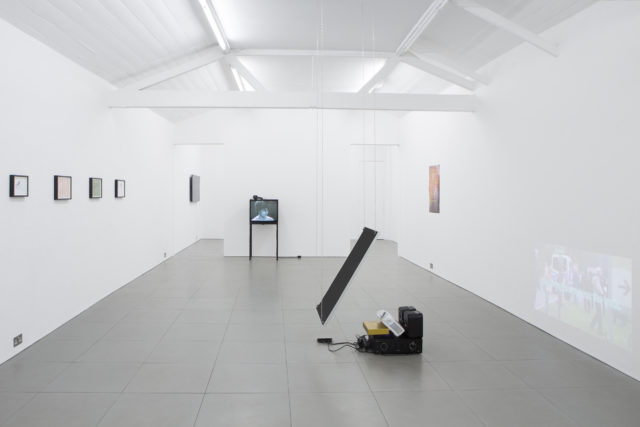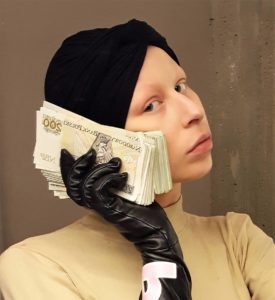In an everyday where words are starting to lose their value, and where the socio-political climate is changing at an ever-growing pace, art seems like a discourse which can reflect on our precarious, vast, networked, post-truth lives. Perverts, running at London’s Cell Project Space April 1 to June 4, is an exhibition of established and emergent artists from the 70s through until now. Featuring the work of Pierre Klossowski, Juliana Huxtable, Keston Sutherland, Stephen G. Rhodes and more, the show is curated in a complex and thoughtful theoretical process, and imagines other possibilities of being (or of being other).

Exploring the relationship between eroticism and desire within reading, the press release defines it as “the gesture of the body… which by one and the same movement posits and perverts its order.” The bodies and the readings that are revealed in Perverts are varied: they are spectators and creators, figurative and abstract; alter-egos, subjects and subalterns. They are individual or collective, all struggling in a constant attempt to unite around a shared passion. Drawings, videos, performance and text pieces each address these body-text-eros questions and form a different position for the spectator to read from. Taken as a whole, Perverts is an intimate experience, a political social exploration of desire and expression; a depiction of a period in which the visual arts celebrates the body-as-text way of being.
Harry Burke’s series of fragmented moments — poems, thoughts, experiences, and drawings typed in letters and keyboard symbols — is at the entrance. They’re chaotically spread on A4 pieces of paper printed with an inkjet and placed in a pile on a shelf next to the door. They are outtakes from a narrative told by someone, by everyone or by no one. This piece is simple but a compelling conceit: the language creates fragmented desires, intimacy and alienation and reflects upon the ubiquity of social media. Its poetic abject voice is read privately, the spectator can leaf through the sheets, their hands touch the surface of the words and follows the layers of the poem: “NO ONE LISTENS” is written in block letters on top of a longer poem “… cats don’t listen / cats cud cuddle it’s cuute.. [sic]”. Following this flux of words, images and fantasies emerge and disappear into a constant feeling of detachment. Burke is of a contemporary kind of artist using words to represent a post-human stream of consciousness; an abject self at once in opposition and complicit with neoliberal ideas of singularity.

Left of Burke’s work, is a poster reproduction of a Bruce Nauman’s ‘Body Pressure.’ The piece, originally written on a typewriter, addresses the spectator directly and guides them to form an image of the beholder’s body by pressing it against another imagined one. The commanding narrative of Nauman’s prose creates an encounter with an erotic ‘other’ as an image. The surface of the wall, or that imagined work of art, seems almost like a utopian space where one can touch the other to create; to form a new body, which reflects both. The artwork’s ending breaks this illusion when it reads, “this may become a very erotic exercise.” The reminder of desire collapses it and cuts the experience of the spectator; language breaks the image with its overruling power. The intimate experience then expands beyond the individual viewer. From this rapture, the poster reflects upon the gallery’s space and positions the viewer in a wider body to expose the impotence of art that dwells in its illusional power.
Zuzanna Bartoszek’s work demands a different kind of reading. Her series of five small ink drawings use both figurative and abstract expression to inscribe constellations of sexual symbols. A naked female figure with a grid for a head spreads her legs to look at a Sphinx sculpture, which looks back at her featureless face. Or a space full of empty tables and chairs arranged and aligned with a faded lying figure of a naked woman. Bartoszek positions the spectator within situations of submission and voyeurism, where human eros and desire, at the point of surrender, objectify and dehumanise.

‘Implosion’ is a video by Loretta Fahrenholz, composed of daily scenes from lives of cool, young queer people, showing parks, interiors, bodies and intimate situations. The narrative appears in a monotonic voiceover and subtitles based on Kathy Acker’s play of the same name, telling the story of two characters in the French Revolution using a language of the 80s New York punk culture. The mix of these layers drains the mesh of emotions and sex appeal and tries to establish a new contemporary eroticism through a lexicon consisting alienation, nihilism and symbols of subculture become fashionable. In Fahrenholz’s world, all is vacuous. Only the beautiful are desired. These bodies are entangled because they are detached. The final result seems almost as if it is an advertisement for the actual work, which is hidden or yet to come.
Also presented in Perverts is a video taken from a reading by Acker herself. She reads her novel Kathy Goes to Haiti, telling the journey story of a young American girl passing through the streets of Port-au-Prince with a man who introduces her to a witch doctor. Acker’s words, as always, reveal sexual tensions in a personal and direct tone. The dramatic black-and-white image of her, sitting on a stage with t-shirt and dark glasses, describing explicit sexual encounters embodies a libidinous rebellion libido that was subversive in 70s subculture, but now seems a bit naive.
If the contemporary moment is characterised by the flux of meaning the of words, then Perverts emphasises this point. Coming at the end of a period when performative readings were a very common and very present site in London’s art galleries, celebrating streams of a shared individual consciousness, Perverts can almost be seen as an awakening. It’s an exhibition that reflects upon language, bodies and desire to reveal their constructions; the distortions of subjectivity, society, and power relations; the position and affect of art in all of the above.
The Perverts group exhibition is on at London’s Cell Project Space, running April 1 to June 4, 2017.














